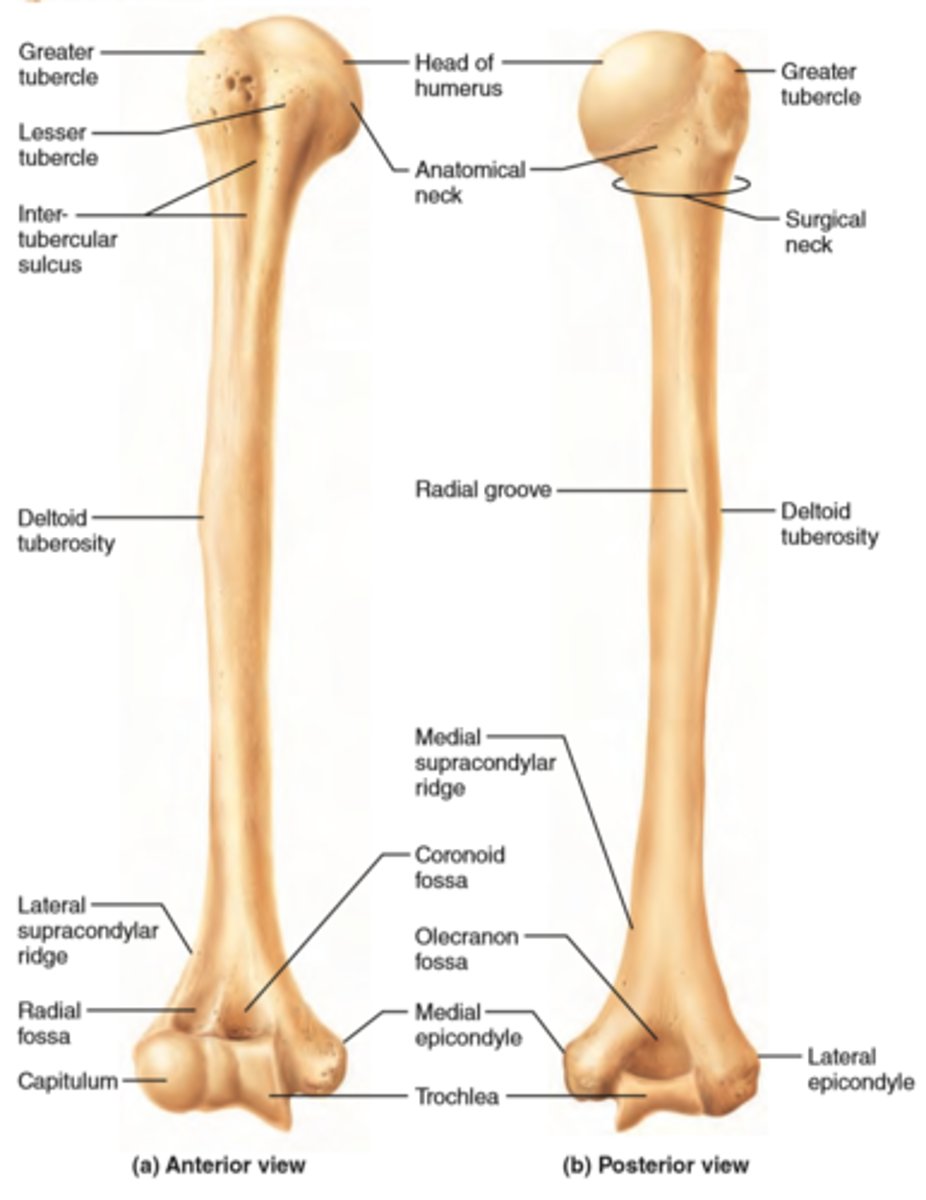Lab #1: Pectoral Girdle, Superficial/ Intermediate back muscles
1/12
There's no tags or description
Looks like no tags are added yet.
Name | Mastery | Learn | Test | Matching | Spaced |
|---|
No study sessions yet.
13 Terms
Trapezius: upper fibers
-trapezius is very superficial!! goes all the way from back of head and all way down to lower back!!
Proximal Attachment/Origin:
-external occipital protuberance
-spinous process of c7 vertebra
-medial 1/3 of superior nuchal line
-ligamentum nuchae
Distal Attachment/ Insertion:
-lateral 1/3 of clavicle
-Acromion process of scapula
Innervation:
-(spinal) accessory CN XI
-C3, C4 nerves
Action: (fixed origin)
1. elevate scapula
-fibers travel upward from scapula to insert into cervical vertebra
2. rotate glenoid cavity superiorly
Action: (fixed insertion)
1. extension, lateral flexion, and contralateral rotation of head and cervical spine
-acting bilaterally trapezius extends neck
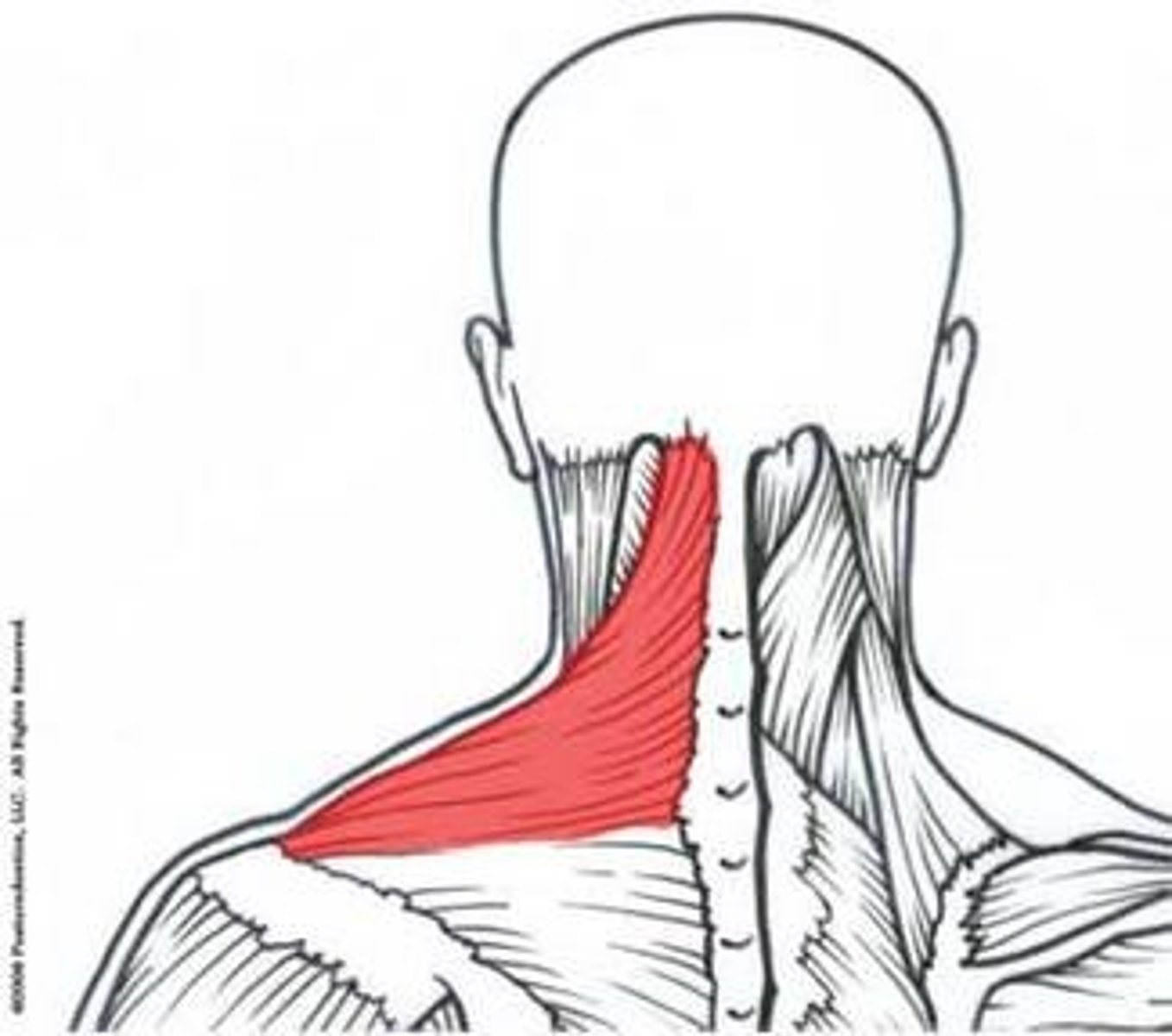
Trapezius: middle fibers
-trapezius is very superficial!! goes all the way from back of head and all way down to lower back!!
Proximal Attachment/ Origin:
-spinous process of T1-T5 vertebrae
(T is for TRAP, middle goes to first half of thoracic)
Distal Attachment/ Insertion:
-medial margin of the acromion process of the scapula
-superior lip of spine of scapula
Innervation:
-Spinal Accessory nerve CN XI
-C3, C4 spinal nerves
Action: (fixed origin)
1. retraction of scapula (pulling back of shoulders)
Action: (fixed insertion)
1. extension, lateral flexion, and contralateral rotation of head and cervical spine
-acting bilaterally trapezius extends neck
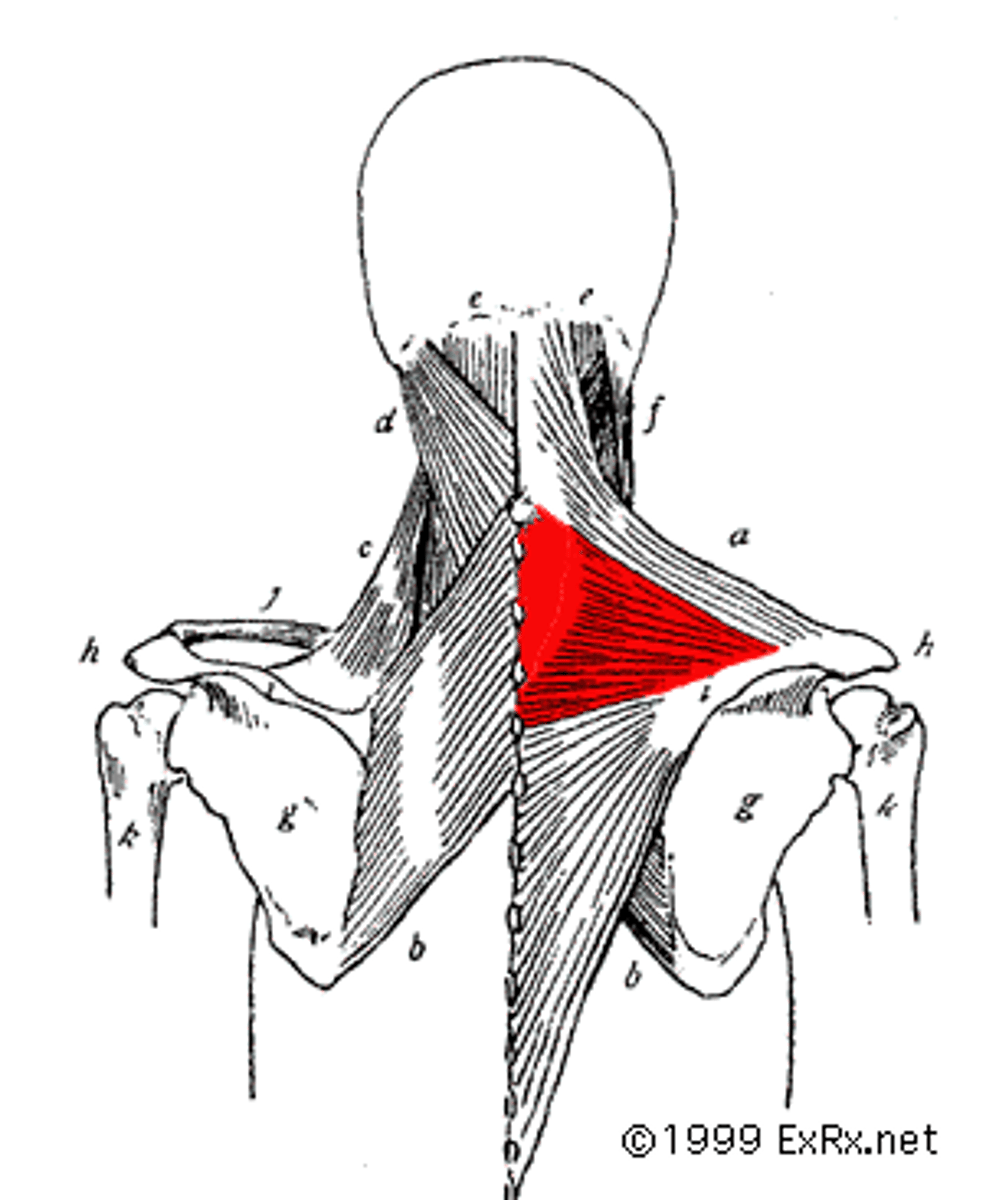
Trapezius: lower fibers
-trapezius is very superficial!! goes all the way from back of head and all way down to lower back!!
Proximal Attachment/ Origin:
-spinous process of T6-T12
(T is for TRAP, lower goes to other half of thoracic)
Distal Attachment/ Insertion:
-tubercle at the apex of spine of scapula
Innervation:
-spinal accessory nerve CN XI
-C3, C4 spinal nerves
Action: (fixed origin)
1. depression of scapula (pull shoulders down)
2. rotate glenoid cavity superiorly
Action: (fixed insertion)
1. extension, lateral flexion, and contralateral rotation of head and cervical spine
-acting bilaterally trapezius extends neck
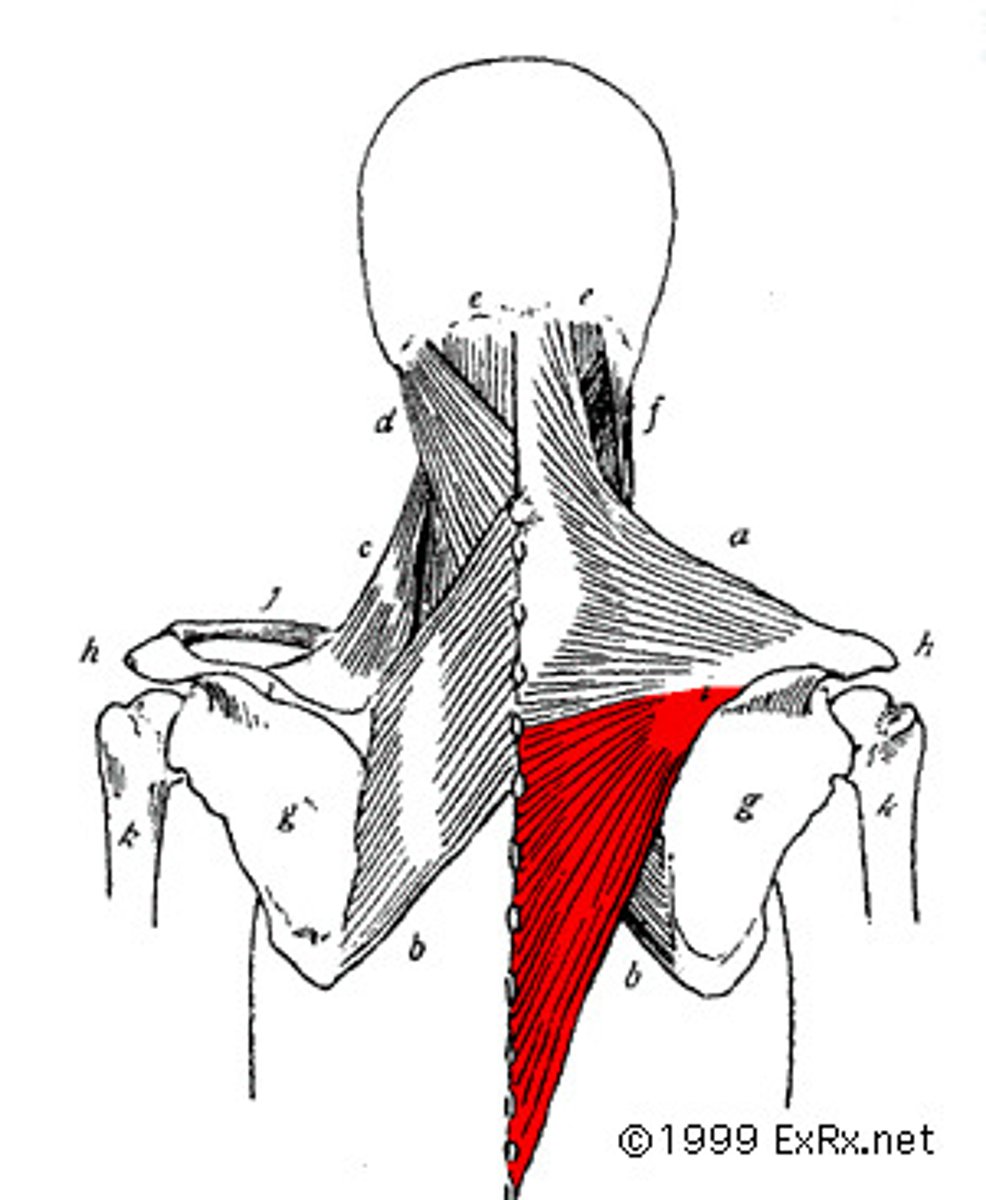
Latissimus Dorsi
-aka: lower back
Proximal Attachment/ Origin:
-spinous process of T6-T12
(same as lower trap)
-thoracolumbar fascia (attaches to a lot of CT)
-posterior lip of iliac crest
-ribs 9 to 12
-tiny bit of inferior angle of scapula
Distal Attachment/ Insertion:
-floor of intertubercular groove of humerus
(ANTERIOR INSERTION!! = goes under armpit!!)
Innervation:
-thoracodorsal nerve, C6, C7, C8
Action: (fixed origin)
1. adducts shoulder
2.internal rotation of shoulder
3. extends shoulder
-with continued contraction, it can depress scapula and laterally flex the trunk
4. hyperextends vertebral column
-when acting bilaterally
Action: (fixed insertion)
5. anteriorly/ laterally tilts pelvis
-when acting bilaterally
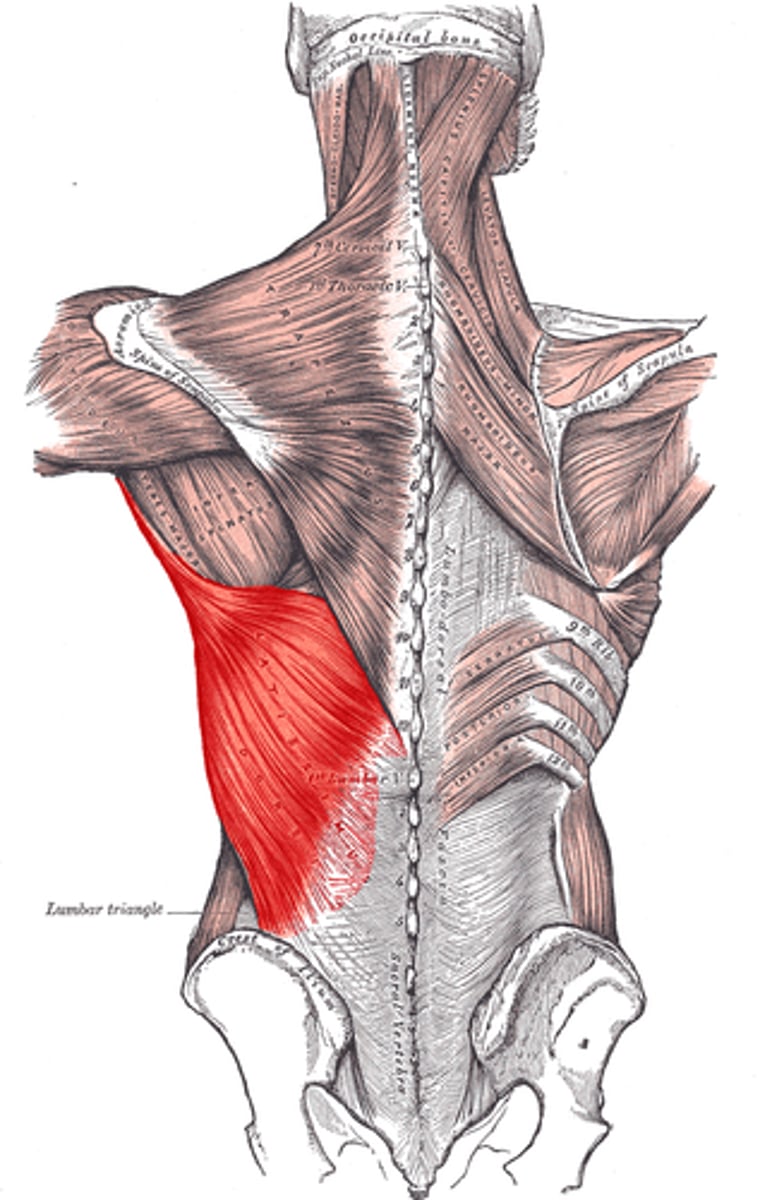
Rhomboid Major
-larger and inferior to rhomboid minor
Proximal Attachment/ Origin:
-spinous process of T2-T5
Distal Attachment/ Insertion:
-medial border of scapula
(between the level of the scapular spine and the inferior angle)
Innervation:
-dorsal scapular nerve, C5
Action:
1. retracts scapula (adduction)
2. elevates scapula
3. downward rotation of scapula
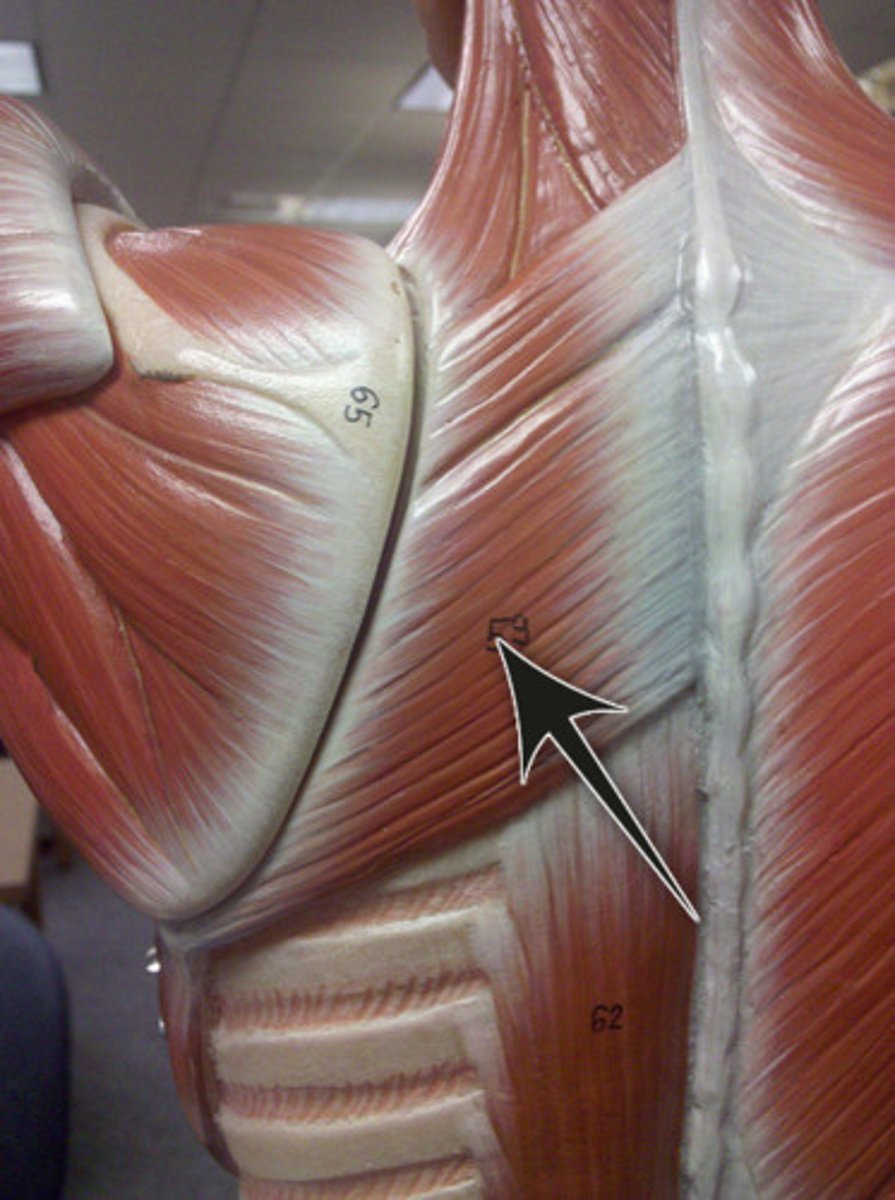
Rhomboid Minor
-smaller and superior to rhomboid major
Proximal Attachment/ Origin:
-nuchal ligament
-spinous process of C7-T1
(deep to upper and middle trap)
Distal Attachment/ Insertion:
-medial border at the root of spine of scapula
Innervation:
-dorsal scapular nerve, C5
Action:
1. retracts scapula
2. downward rotation of scapula
-pulls at top of scapula to cause anterior tilt
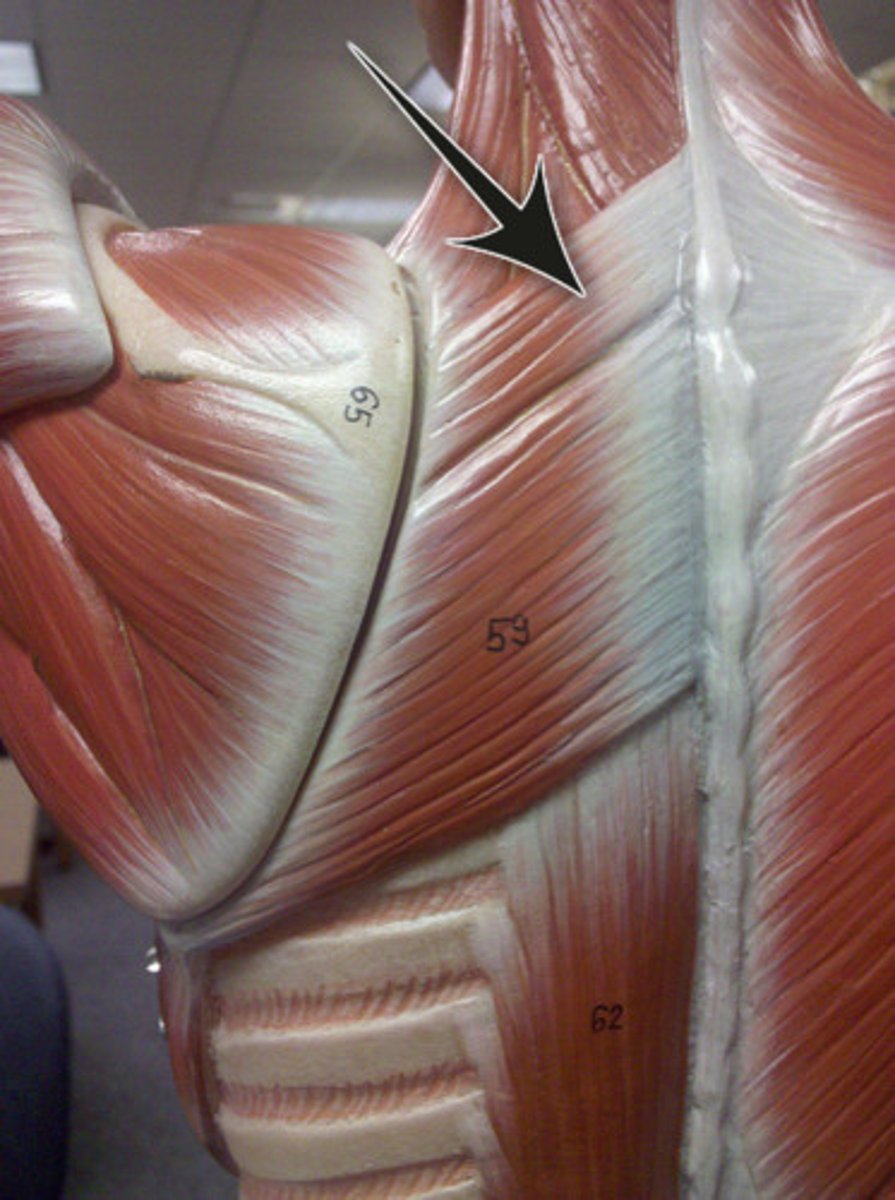
Serratus Posterior Superior
Proximal Attachment/ Origin:
-Spinous Process of T1-T3 vertebrae
Distal Attachment/ Insertion:
-upper borders of ribs 2-5
Innervation:
-intercostal nerves T2-T5
Action:
-elevates ribs
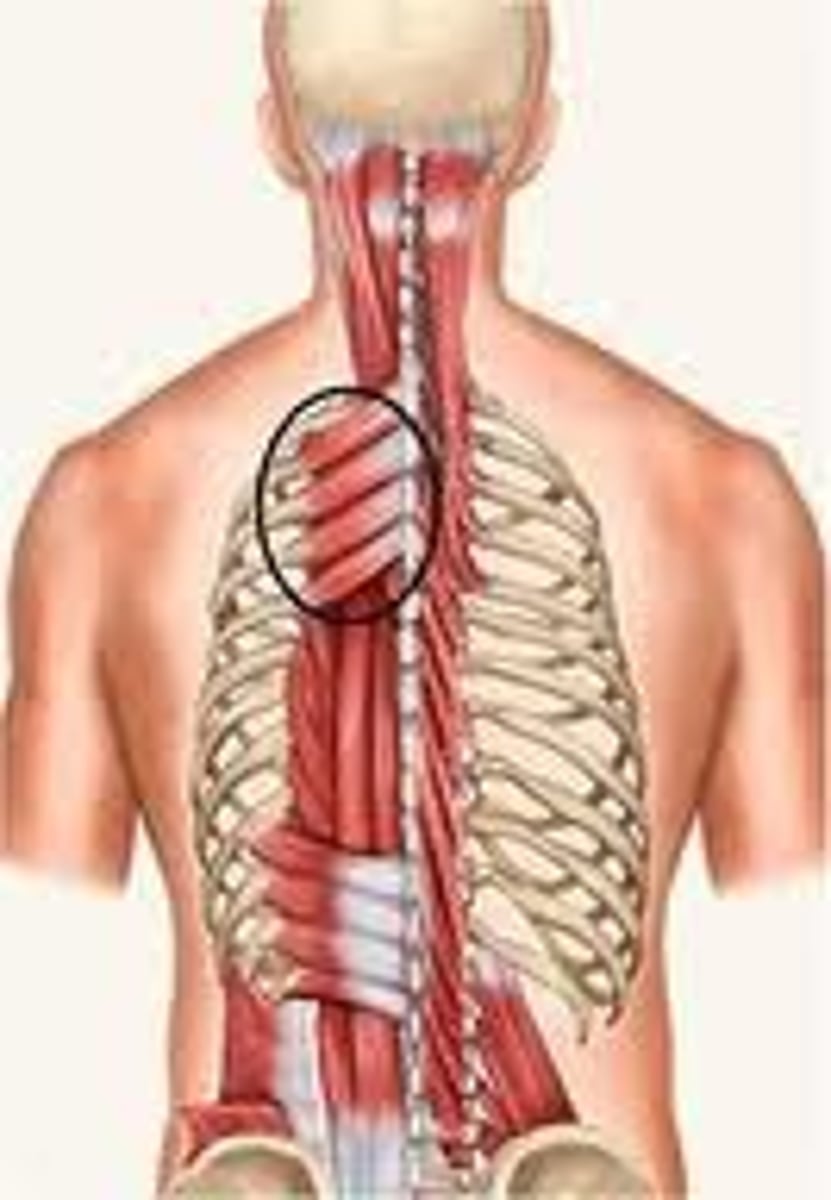
Serratus Posterior Inferior
Proximal Attachment/ Origin:
-spinous process of T11-L2 vertebrae
Distal Attachment/ Insertion:
-inferior border of ribs 9-12
Innervation:
-intercostal nerves T9-T12
Action:
-depress ribs
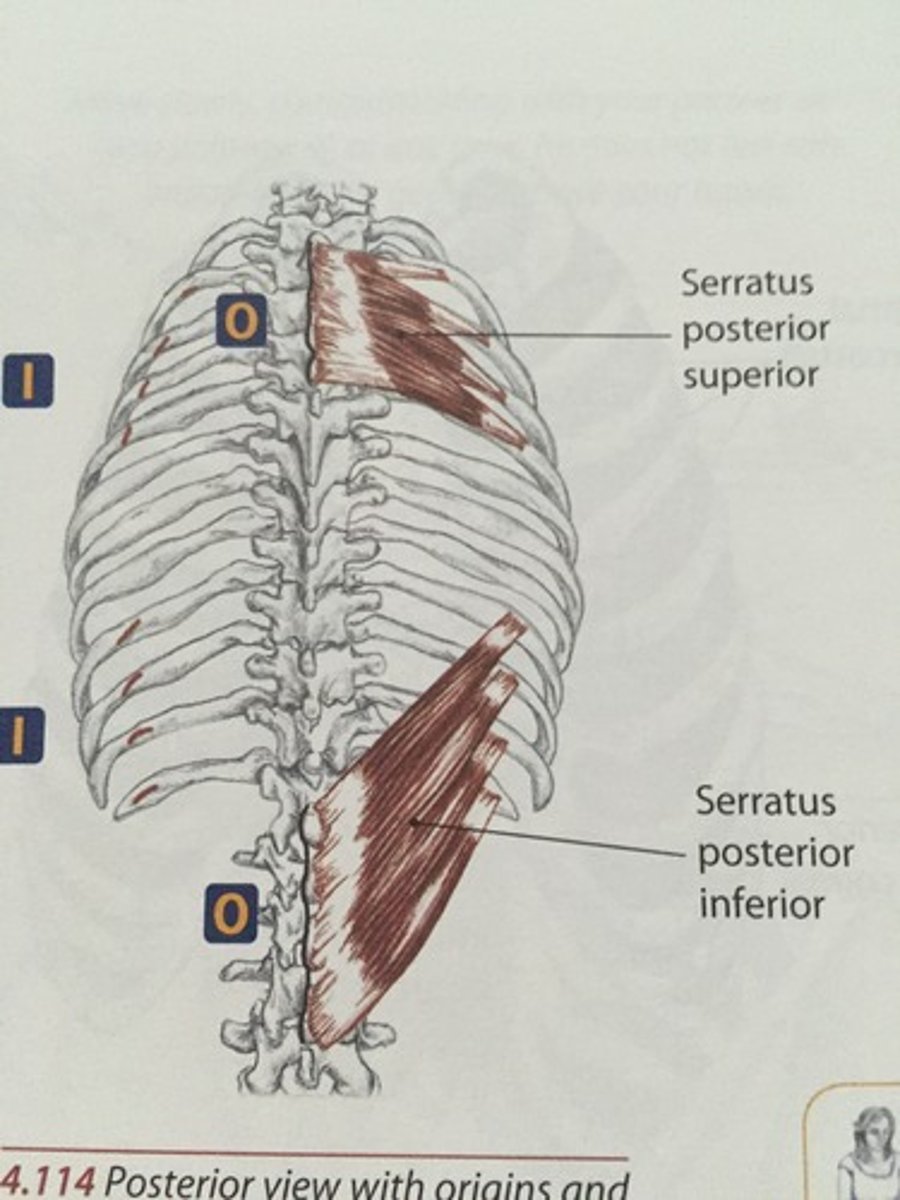
Levator Scapulae
-above the scapula
-find the superior angle of scapula to locate it
-muscle fibers are very vertical
Proximal Attachment/ Origin:
-posterior tubercles of transverse processes of C1-C4 vertebrae
Distal Attachment/ Insertion:
-medial border of scapula
(between superior angle and root of scapula spine)
Innervation:
-dorsal scapular nerve, C4, C5
-cervical spinal nerve C3, C4
Action: (fixed origin)
-elevates scapula
-downward rotation of scapula
Action: (fixed insertion working UNILATERALLY)
-lateral flexion and ipsilateral rotation of cervical spine
Action: (fixed insertion working BILATERALLY)
-extension of cervical spine
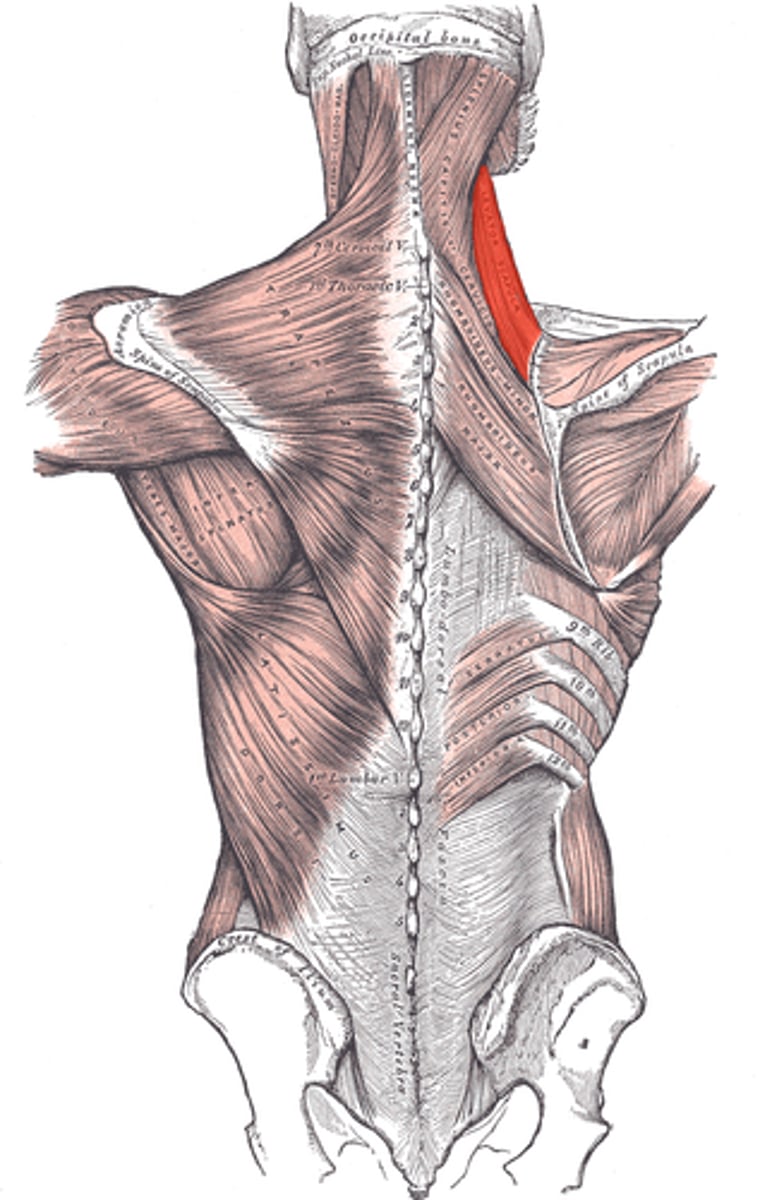
Major Regions and Bony Landmarks: Sternum
1. manubrium
-clavicular notch (two)
-jugular notch (one)
2. body of sternum
3. xiphoid process
-tip at bottom
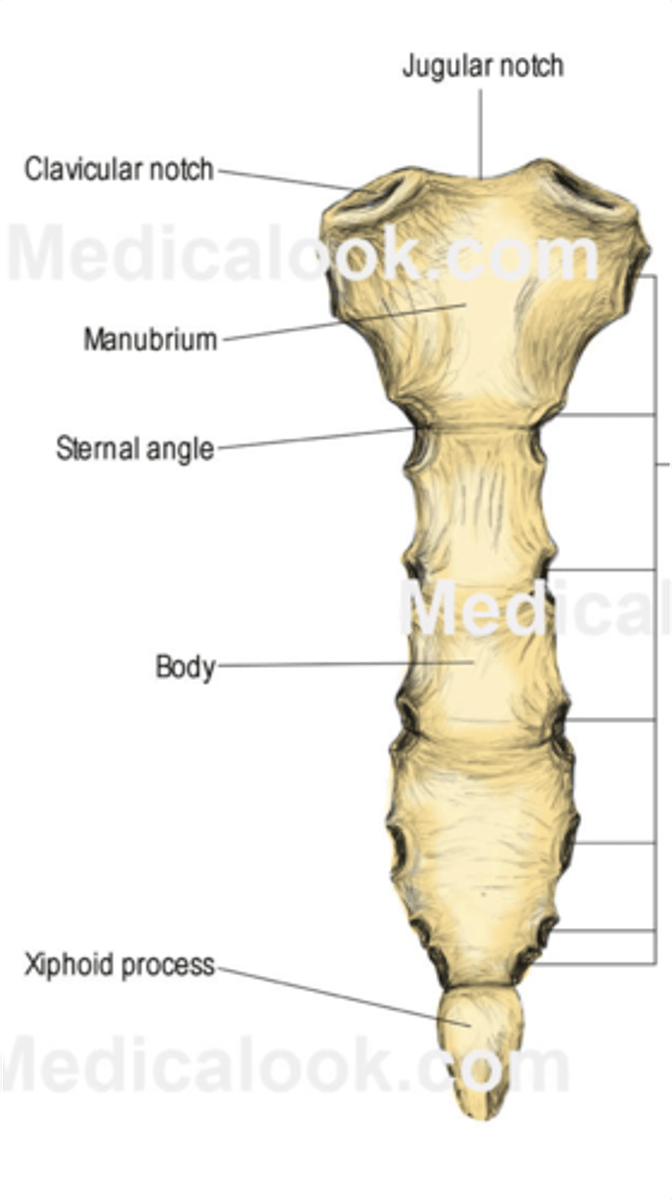
Major Regions and Bony Landmarks: Clavicle
1. sternal end with facet
-rounded, sharp cut-off end
-medial end
2. acromial end with facet
-taper off into flat end
-lateral end
3. superior surface
-"smooth" superior
4. inferior surface
-bumpy
5. conoid tubercle
-on posterior- inferior side
-near acromial/lateral end
6. trapezoid line
-on posterior-inferior side
-near acromial/lateral end
-extends from conoid tubercle to acromial end
7. subclavian groove
-on inferior surface
8. shaft
-body of clavicle
HOW TO SIDE:
1. superior vs. inferior
-smooth superior
-conoid tubercle is inferior
2. posterior vs. anterior
-anterior sticks out
-should form crossbow when put together
3. lateral vs. medial end
-sternal (sharp cut off) end= medial
-acromial (flat/ tapers off) end= lateral
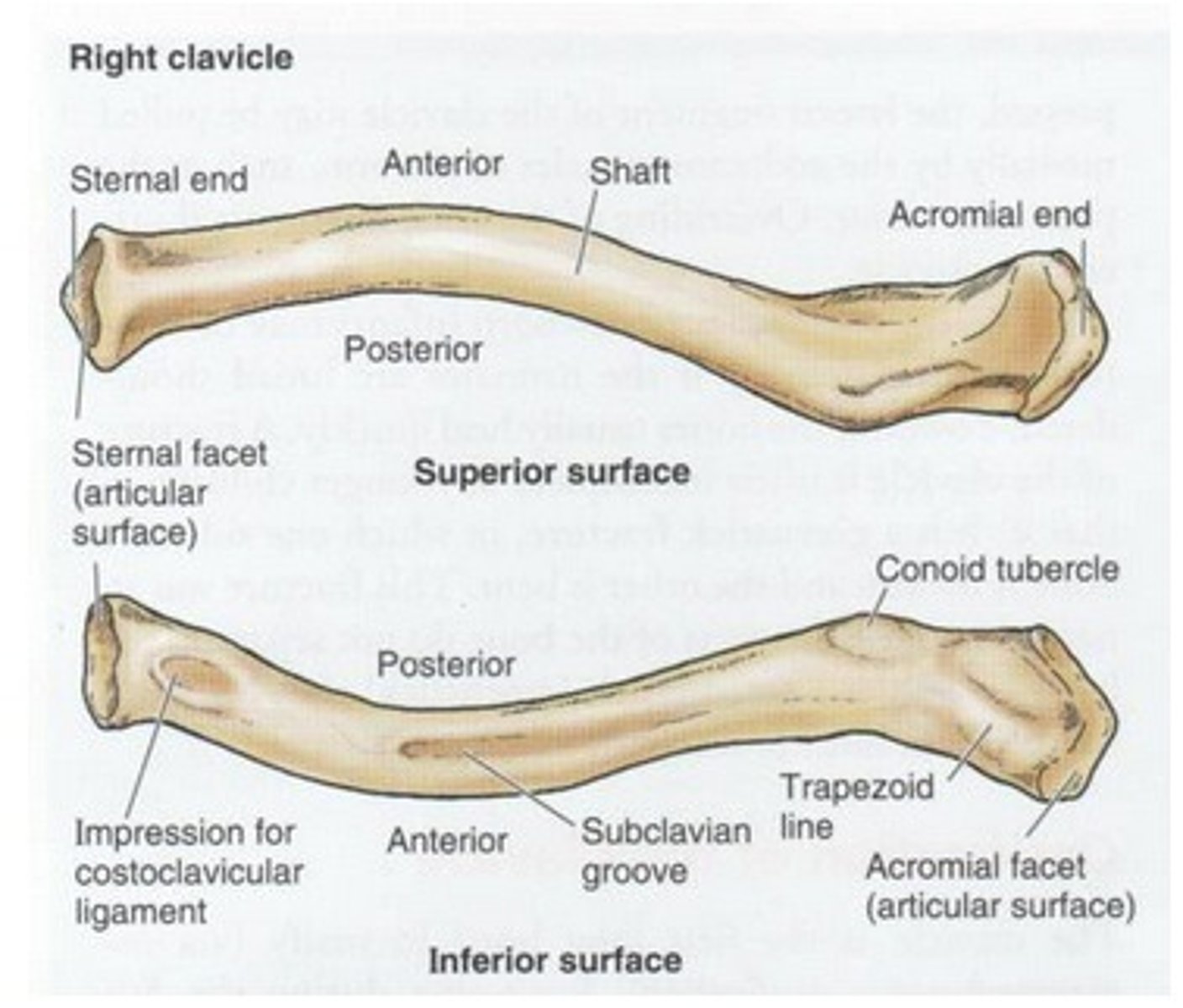
Major Regions and Bony Landmarks: Scapula
1. Dorsal/ posterior surface
-has the spine
2. Costal/ anterior surface
3. medial (vertebral) border
4. lateral (axillary) border
-near glenoid cavity
5. superior angle
6. inferior angle
7. spine of scapula
8. supraspinous fossa
-above the spine
9. infraspinous fossa
-below the spine
10. subscapular fossa
-on anterior side
11. acromion
-found laterally and posteriorly
-at end of spine, looks like hook
12. coracoid process
-found laterally and anteriorly
13. suprascapular notch
-at base of coracoid process
14. glenoid cavity
-most lateral
-circular depression
15. supraglenoid tubercle
-above glenoid cavity
16. infraglenoid tubercle
-below glenoid cavity
HOW TO SIDE:
1. lateral vs. medial
-acromion, coracoid process, and glenoid cavity are lateral
2. anterior/ costal vs. dorsal surface
-spine of scapula is posterior
-subscapular fossa is anterior
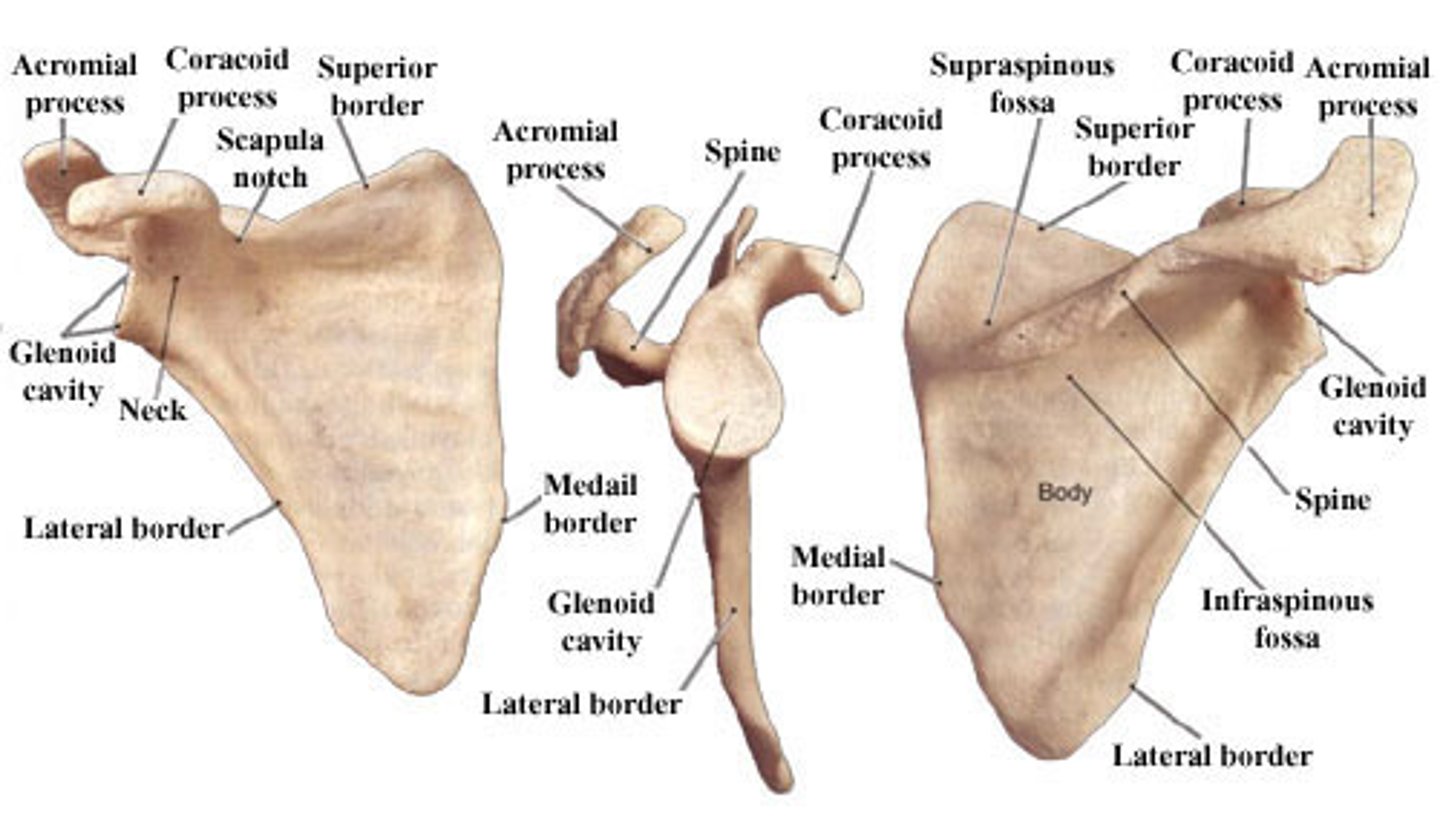
Major Regions and Bony Landmarks: Humerus (proximal)
1. head of humerus
-big ball
-it is medial
2. anatomical neck
-ridge that lines head
3. surgical neck
-thinning of bone below head
4. greater tubercle
-lateral
5. crest of greater tubercle
-ridge that extends from greater tubercle
6. lesser tubercle
-most anterior
7. crest of lesser tubercle
-ridge that extends from lesser tubercle
8. intertubercular sulcus
-groover between the two tubercles
9. deltoid tuberosity
-bump on lateral side about halfway down
10. radial groove
-faint diagonal line originating in the posterior
HOW TO SIDE:
1. medial vs. lateral
-head is medial
-deltoid tuberosity is lateral
2. anterior vs. posterior
-lesser tubercle is anterior
